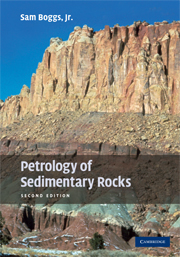Book contents
- Frontmatter
- Contents
- Preface
- Part I Principles
- Part II Siliciclastic sedimentary rocks
- Chapter 2 Sedimentary textures
- Chapter 3 Sedimentary structures
- Chapter 4 Sandstones
- Chapter 5 Conglomerates
- Chapter 6 Mudstones and shales
- Chapter 7 Provenance of siliciclastic sedimentary rocks
- Chapter 8 Diagenesis of sandstones and shales
- Part III Carbonate sedimentary rocks
- Part IV Other chemical/biochemical sedimentary rocks and carbonaceous sedimentary rocks
- References
- Index
- References
Chapter 5 - Conglomerates
from Part II - Siliciclastic sedimentary rocks
Published online by Cambridge University Press: 05 June 2012
- Frontmatter
- Contents
- Preface
- Part I Principles
- Part II Siliciclastic sedimentary rocks
- Chapter 2 Sedimentary textures
- Chapter 3 Sedimentary structures
- Chapter 4 Sandstones
- Chapter 5 Conglomerates
- Chapter 6 Mudstones and shales
- Chapter 7 Provenance of siliciclastic sedimentary rocks
- Chapter 8 Diagenesis of sandstones and shales
- Part III Carbonate sedimentary rocks
- Part IV Other chemical/biochemical sedimentary rocks and carbonaceous sedimentary rocks
- References
- Index
- References
Summary
Introduction
Siliciclastic sedimentary rocks that consist predominantly of gravel-size (> 2 mm) clasts are called conglomerates. The Latin-derived term rudite is also sometimes used for these rocks. Conglomerates are common rocks in stratigraphic sequences of all ages, but make up less than about one percent by weight of the total sedimentary rock mass (Garrels and McKenzie, 1971, p. 40). Geologists have focused a level of attention on conglomerates, judged by the number of published papers, quite out of proportion to their relative abundance. This focus stems from their usefulness in tectonic and provenance analysis (Chapter 7) and the growing interest of sedimentologists in the rather specialized depositional environments of conglomerates. Also, some conglomerates serve as reservoir rocks for oil and gas.
The framework grains of conglomerates are composed mainly of rock fragments (clasts) rather than individual mineral grains. These clasts may consist of any kind of rock. Some conglomerates are composed almost entirely of highly durable clasts of quartzite, chert, or vein quartz. Others are composed of a variety of clasts, some of which, limestone and shale clasts for example, may be unstable or weakly durable. Conglomerates may contain various amounts of matrix, which commonly consists of clay- or sand-size particles or a mixture of clay and sand.
Owing to their coarse grain size, conglomerates do not lend themselves readily to study in the laboratory. They are studied primarily in the field, by a variety of techniques.
- Type
- Chapter
- Information
- Petrology of Sedimentary Rocks , pp. 165 - 193Publisher: Cambridge University PressPrint publication year: 2009



